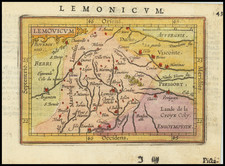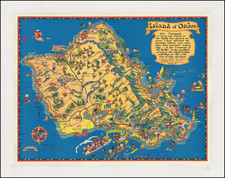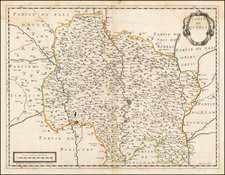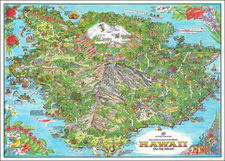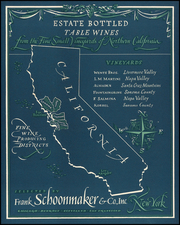Enigmatic Drawing Showing Scenes from Rochecotte During the German Invasion, Probably by a Local Resident.
The castle Rochecotte is a house of the late eighteenth century located in the village of Saint-Patrice, near Langeais, Indre-et-Loire. It has been listed as a historical monument since May 22, 1948. At the bottom center, a book is illustrated, with the title Histoire Horrifique du Gargantua, reference to the work of Francois Rabelais, whose portrait appears at the right and whose name can be seen below the portrait.
During the Second World War, diplomatic archives of the Ministry of Foreign Affairs were moved to Rochecotte, including the original Treaty of Versailles, which Georges Clemenceau had signed in the Hall of Mirrors in 1919, the Treaty of Saint-Germain- en-Laye (1919), as well as other treaties, including that of Westphalia (which ended the Thirty Years' War), and stored in an annex (the Girollet Foundation). These are shown in the upper left side of the poster.
As early as June 1940, the Germans became interested in diplomatic archives and inquired at the Quai d'Orsay. At the end of June, Germans visited Rochecotte, including Karl Epting, a collaborator of the German ambassador Otto Abetz. At the beginning of August, the Germans claimed that shots were fired at Saint-Patrice and used this to tighten their surveillance around Rochecotte. Following this, they asked to see more closely the contents of the coffers of the "treaty room." The French officials believed the Germans would only find the German ratification copy of the treaty, bound in brown leather, the original being safe in Bordeaux. Yet upon opening the wooden boxes, the Germans found the original Treaty of Versailles, bound in white leather.
The Treaty of Versailles was confiscated by the Germans on August 11 or 12, 1940, and taken to Berlin to be presented to Adolf Hitler. Recovered by the Soviet army in Czechoslovakia, it was not included in the batch of documents returned to the French State in 1993 and 1994 and appears to remain missing.
This work is enigmatic in many ways. Elegantly designed and very attractive, it appears to tell several different vignettes. Cars can be seen traveling to Bordeaux, likely representing the self-exile of citizens from Paris to Vichy France. Overlain are industrial or military vehicles. Disjointed images paint the rest of the scene: what does Esso gasoline or abandoned baby clothes have to do with the rest of the image? Why refer to the works of Rabelais? How do these relate to Rochecotte Chateau? And of course, how much of the imagery was chosen to circumvent Nazi censors?
The text on the verso, titled "explenation" may provide some clues if it can be fully deciphered. In nearly illegible handwriting, it is written from the point of view of the author. The snippets that are understandable appear to describe the scenes in the image, such as that with the cat. The writer gives details as to the nature of these images of idyllic rural France, while describing the more unpleasant portrayals as well and referring to something that "preoccupies them at the moment."
Perhaps this image is simply a painted record of the scenes that the rural town of Rochecotte would have witnessed in June and July 1940, including the drama regarding historical artefacts and a flow of refugees, but also the perpetuation of normal life, with denizens still frequenting parks and businesses still operating. Interpreted in this manner, this image is an analysis of how life continues even in the darkest of times.











![Gallia Narbonens [on sheet with] Savaudiae Ducat. [on sheet with] Venuxini Comitatus Descr.](https://storage.googleapis.com/raremaps/img/small/61471.jpg)
